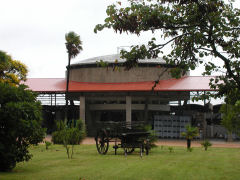 Juanicó – It’s kind of fun to find out little interesting tidbits of history as you travel around. For example, did you know that France was in such bad shape during World War II that they turned to Uruguay for help? At the time, Uruguay was a country that had been built up by many wealthy European expats, and they lent a hand to the French people in the form of food (primarily beef), wool, timber and agricultural products. Unable to repay its debt directly, the French government showed up in 1946 and built this amazing 2,000 acre gravity fed winery – an architectural curiosity (take away the red roof in the picture, which is a very recent addition, and it looks a bit like a giant concrete UFO on stilts), showed the Uruguayans how to make wine and how to distill the wine to make… Cognac.
Juanicó – It’s kind of fun to find out little interesting tidbits of history as you travel around. For example, did you know that France was in such bad shape during World War II that they turned to Uruguay for help? At the time, Uruguay was a country that had been built up by many wealthy European expats, and they lent a hand to the French people in the form of food (primarily beef), wool, timber and agricultural products. Unable to repay its debt directly, the French government showed up in 1946 and built this amazing 2,000 acre gravity fed winery – an architectural curiosity (take away the red roof in the picture, which is a very recent addition, and it looks a bit like a giant concrete UFO on stilts), showed the Uruguayans how to make wine and how to distill the wine to make… Cognac. 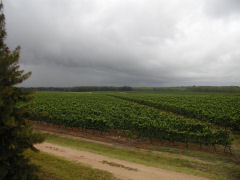 And yes, Cognac, a controlled appellation name in France and worldwide – with one exception… Uruguay. Uruguayans are allowed to produce brandy, from the classic Ugni Blanc grape, and call it Cognac… and even ship it to the European Union! At one time, this property was dedicated to the growing of Ugni blanc and production of Uruguayan Cognac.
And yes, Cognac, a controlled appellation name in France and worldwide – with one exception… Uruguay. Uruguayans are allowed to produce brandy, from the classic Ugni Blanc grape, and call it Cognac… and even ship it to the European Union! At one time, this property was dedicated to the growing of Ugni blanc and production of Uruguayan Cognac.
In 1979 the winery was bought from the Uruguayan government by the Deicas family, who uprooted and replanted the vineyards with various other varietals (there is still a smallish plot of Ugni blanc grown, but they no longer distill their own brandy). Primarily a “bulk wine” producer at 70% of their production (which totals more than 4.4 million liters), the Juanicó winery; named for the first Spanish owner who bought the property in 1830 – the railway station and then the town grew up around it and took on the same name; in fact, the railway station and the police station for the town literally flank the gates to the property. 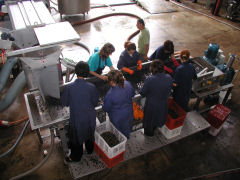 They buy quite a bit of their grapes from other growers under a managed vineyard program, as, of the 2,000 acres only about 500 are currently planted with grapes. According to the Export Manager (yes, we got treated to another team of marketing folks, though these guys were a bit more knowledgeable about the vineyards, facts, and figures), a charming and loquacious gentleman from London, the winery is “semi-organic” in that they do spray to prevent botrytis (a type of rot that affects grapes in a humid climate), but other than that leave everything to natural balance – things like insect control via other insects and birds, complete waste recycling onsite. (There is only one certified organic winery in Uruguay, La Cruz, a small, 75 acre vineyard.) Despite their size, and all the equipment, the work for the fine wine is still done by hand, like this seven-person manual sorting line to pick out the rotten grapes and stems.
They buy quite a bit of their grapes from other growers under a managed vineyard program, as, of the 2,000 acres only about 500 are currently planted with grapes. According to the Export Manager (yes, we got treated to another team of marketing folks, though these guys were a bit more knowledgeable about the vineyards, facts, and figures), a charming and loquacious gentleman from London, the winery is “semi-organic” in that they do spray to prevent botrytis (a type of rot that affects grapes in a humid climate), but other than that leave everything to natural balance – things like insect control via other insects and birds, complete waste recycling onsite. (There is only one certified organic winery in Uruguay, La Cruz, a small, 75 acre vineyard.) Despite their size, and all the equipment, the work for the fine wine is still done by hand, like this seven-person manual sorting line to pick out the rotten grapes and stems.
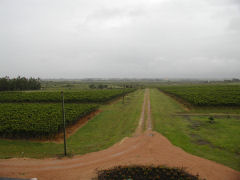 Juanicó is actually two separate properties, a mile or two apart. The main vineyards are planted to a wide variety of grapes, including an entire section devoted to experimentation. The winery is also located there. The second property, shown here, is significantly smaller, and is planted specifically to Tannat. This property is a joint venture with the Magrez family (Château Pape-Clement and others in Bordeaux) to produce a wine called Cru Garage, after the garagistes in Bordeaux. While they currently don’t actually make the wine in a garage, or even in a small winery, the idea is a much more handcrafted, high quality wine. The house on this site is being renovated, along with its garage – and the plan is to turn the latter into an onsite winery and make the wine completely separately from the main production.
Juanicó is actually two separate properties, a mile or two apart. The main vineyards are planted to a wide variety of grapes, including an entire section devoted to experimentation. The winery is also located there. The second property, shown here, is significantly smaller, and is planted specifically to Tannat. This property is a joint venture with the Magrez family (Château Pape-Clement and others in Bordeaux) to produce a wine called Cru Garage, after the garagistes in Bordeaux. While they currently don’t actually make the wine in a garage, or even in a small winery, the idea is a much more handcrafted, high quality wine. The house on this site is being renovated, along with its garage – and the plan is to turn the latter into an onsite winery and make the wine completely separately from the main production.
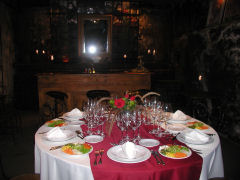 For lunch we launched into a pretty much classic asado or mixed grill, thankfully not with quite the range of the usual version as we had more visits to make and time was growing short. We ate at this beautiful table in the cellar of the main house, starting off with cheeses and meats, a salad that could have been a meal in itself, followed swiftly by a delciious selection of chorizos and mollejas (sweetbreads), then lamb shortribs and slices of lomo, or sirloin, and moving on to a slightly underdone but quite good apple tart served with vanilla ice cream and a mixed berry sauce.
For lunch we launched into a pretty much classic asado or mixed grill, thankfully not with quite the range of the usual version as we had more visits to make and time was growing short. We ate at this beautiful table in the cellar of the main house, starting off with cheeses and meats, a salad that could have been a meal in itself, followed swiftly by a delciious selection of chorizos and mollejas (sweetbreads), then lamb shortribs and slices of lomo, or sirloin, and moving on to a slightly underdone but quite good apple tart served with vanilla ice cream and a mixed berry sauce.
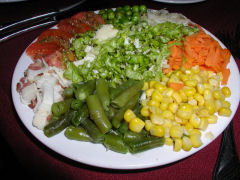
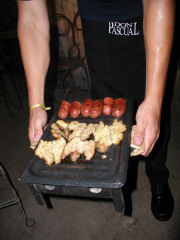
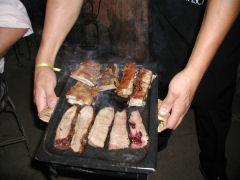
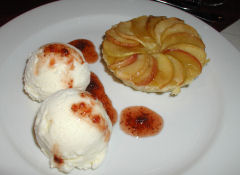





 Juanicó – It’s kind of fun to find out little interesting tidbits of history as you travel around. For example, did you know that France was in such bad shape during World War II that they turned to Uruguay for help? At the time, Uruguay was a country that had been built up by many wealthy European expats, and they lent a hand to the French people in the form of food (primarily beef), wool, timber and agricultural products. Unable to repay its debt directly, the French government showed up in 1946 and built this amazing 2,000 acre gravity fed winery – an architectural curiosity (take away the red roof in the picture, which is a very recent addition, and it looks a bit like a giant concrete UFO on stilts), showed the Uruguayans how to make wine and how to distill the wine to make… Cognac.
Juanicó – It’s kind of fun to find out little interesting tidbits of history as you travel around. For example, did you know that France was in such bad shape during World War II that they turned to Uruguay for help? At the time, Uruguay was a country that had been built up by many wealthy European expats, and they lent a hand to the French people in the form of food (primarily beef), wool, timber and agricultural products. Unable to repay its debt directly, the French government showed up in 1946 and built this amazing 2,000 acre gravity fed winery – an architectural curiosity (take away the red roof in the picture, which is a very recent addition, and it looks a bit like a giant concrete UFO on stilts), showed the Uruguayans how to make wine and how to distill the wine to make… Cognac.  And yes, Cognac, a controlled appellation name in France and worldwide – with one exception… Uruguay. Uruguayans are allowed to produce brandy, from the classic Ugni Blanc grape, and call it Cognac… and even ship it to the European Union! At one time, this property was dedicated to the growing of Ugni blanc and production of Uruguayan Cognac.
And yes, Cognac, a controlled appellation name in France and worldwide – with one exception… Uruguay. Uruguayans are allowed to produce brandy, from the classic Ugni Blanc grape, and call it Cognac… and even ship it to the European Union! At one time, this property was dedicated to the growing of Ugni blanc and production of Uruguayan Cognac. They buy quite a bit of their grapes from other growers under a managed vineyard program, as, of the 2,000 acres only about 500 are currently planted with grapes. According to the Export Manager (yes, we got treated to another team of marketing folks, though these guys were a bit more knowledgeable about the vineyards, facts, and figures), a charming and loquacious gentleman from London, the winery is “semi-organic” in that they do spray to prevent botrytis (a type of rot that affects grapes in a humid climate), but other than that leave everything to natural balance – things like insect control via other insects and birds, complete waste recycling onsite. (There is only one certified organic winery in Uruguay, La Cruz, a small, 75 acre vineyard.) Despite their size, and all the equipment, the work for the fine wine is still done by hand, like this seven-person manual sorting line to pick out the rotten grapes and stems.
They buy quite a bit of their grapes from other growers under a managed vineyard program, as, of the 2,000 acres only about 500 are currently planted with grapes. According to the Export Manager (yes, we got treated to another team of marketing folks, though these guys were a bit more knowledgeable about the vineyards, facts, and figures), a charming and loquacious gentleman from London, the winery is “semi-organic” in that they do spray to prevent botrytis (a type of rot that affects grapes in a humid climate), but other than that leave everything to natural balance – things like insect control via other insects and birds, complete waste recycling onsite. (There is only one certified organic winery in Uruguay, La Cruz, a small, 75 acre vineyard.) Despite their size, and all the equipment, the work for the fine wine is still done by hand, like this seven-person manual sorting line to pick out the rotten grapes and stems. Juanicó is actually two separate properties, a mile or two apart. The main vineyards are planted to a wide variety of grapes, including an entire section devoted to experimentation. The winery is also located there. The second property, shown here, is significantly smaller, and is planted specifically to Tannat. This property is a joint venture with the Magrez family (Château Pape-Clement and others in Bordeaux) to produce a wine called Cru Garage, after the garagistes in Bordeaux. While they currently don’t actually make the wine in a garage, or even in a small winery, the idea is a much more handcrafted, high quality wine. The house on this site is being renovated, along with its garage – and the plan is to turn the latter into an onsite winery and make the wine completely separately from the main production.
Juanicó is actually two separate properties, a mile or two apart. The main vineyards are planted to a wide variety of grapes, including an entire section devoted to experimentation. The winery is also located there. The second property, shown here, is significantly smaller, and is planted specifically to Tannat. This property is a joint venture with the Magrez family (Château Pape-Clement and others in Bordeaux) to produce a wine called Cru Garage, after the garagistes in Bordeaux. While they currently don’t actually make the wine in a garage, or even in a small winery, the idea is a much more handcrafted, high quality wine. The house on this site is being renovated, along with its garage – and the plan is to turn the latter into an onsite winery and make the wine completely separately from the main production. For lunch we launched into a pretty much classic asado or mixed grill, thankfully not with quite the range of the usual version as we had more visits to make and time was growing short. We ate at this beautiful table in the cellar of the main house, starting off with cheeses and meats, a salad that could have been a meal in itself, followed swiftly by a delciious selection of chorizos and mollejas (sweetbreads), then lamb shortribs and slices of lomo, or sirloin, and moving on to a slightly underdone but quite good apple tart served with vanilla ice cream and a mixed berry sauce.
For lunch we launched into a pretty much classic asado or mixed grill, thankfully not with quite the range of the usual version as we had more visits to make and time was growing short. We ate at this beautiful table in the cellar of the main house, starting off with cheeses and meats, a salad that could have been a meal in itself, followed swiftly by a delciious selection of chorizos and mollejas (sweetbreads), then lamb shortribs and slices of lomo, or sirloin, and moving on to a slightly underdone but quite good apple tart served with vanilla ice cream and a mixed berry sauce.



More on this, as this story develops – but my friend Ken couldn’t find any official info on the whole Uruguayan cognac thing I talked about above, which initiated a lively search through the internet and some inquiries sent out to various and sundry. We shall see what more info we dredge up. I found numerous references to Juanicó Cognac, including pictures of bottles, and even including Mercosur’s export product page, which lists two different blends currently for export from South America. I also found a resolution by the national assembly of France to, if my French isn’t completely off-base, “put a stop to these trademark usurpers” (which also included Chilean Armagnac and Chilean Calvados) and having passed a resolution two years ago to do so. It goes into effect in typically swift French fashion, in February 2015.
The gift of the vineyard from the french government was given after WWI. not WWII, I have visited the vineyard many times there and Juanico Cognac is available in restaurants and liquor stores and supermarkets throughout Uruguay.
I’m basing things on the information they gave me at the winery, part of their press materials and in an interview for the article I was writing, where they specifically stated WWII – which also kind of fits with the 1946 date of the French arrival to assist with the vineyard. And, while the internet is not the be all and end all of the record, there are numerous references to it being the 2nd, summed up by this: “The only other place where Cognac can be made is in Uruguay. After World War II, France paid its debts to ANCAP of Uruguay with Ugni Blanc, know-how for making Cognac, and the right to use the denomination.” – which came from the ANCAP website.